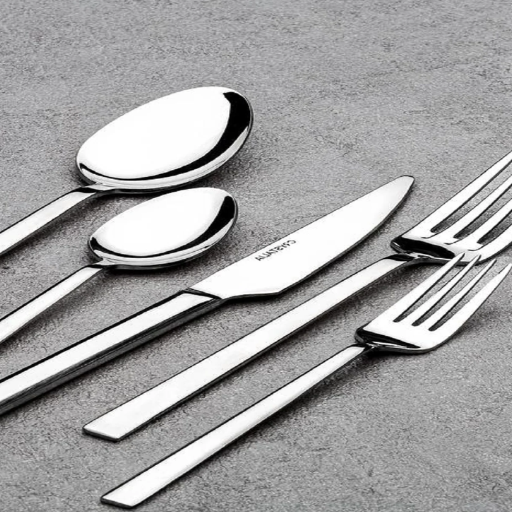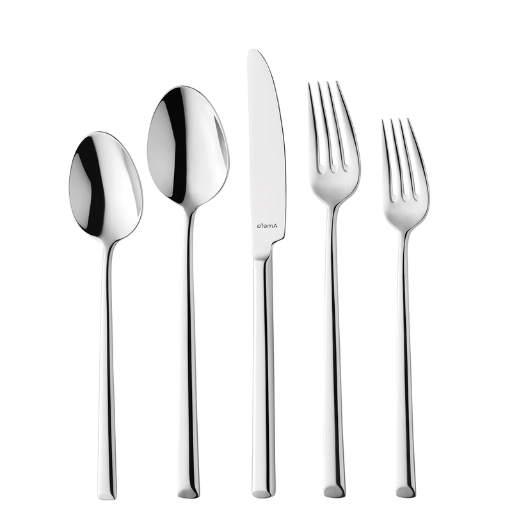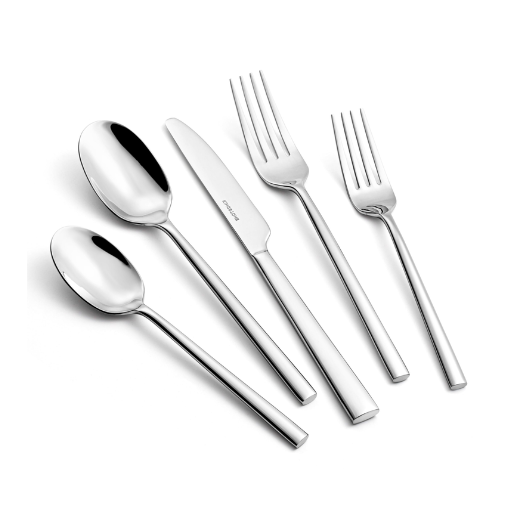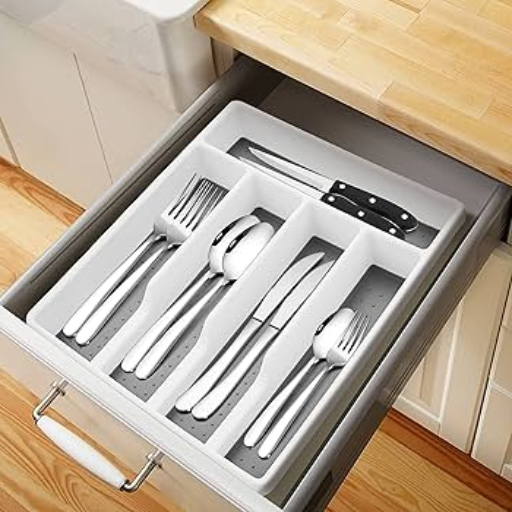The material of flatware and cutlery has a profound impact on its durability and design. Stainless steel 18/10 is among the most popular materials, but is widely renowned for its quality and performance. Does it stand out that much? In this article, we will examine its composition, advantages, and specific features to determine if it’s right for your home. Whether you seek which number corresponds to which part of the cutlery set or want to upgrade your current one, this guide will help you make an informed decision. Keep reading to find out why 18/10 stainless steel is the ideal blend of practicality and beauty.
What Makes 18/10 Stainless Steel Flatware the Best Quality?

The reason why 18/10 stainless steel flatware is considered to be of the best quality is due to the remarkable durability it offers, the ability to resist corrosion and rust, and the finish of the object. The part of ’18/10′ refers to the ratio by composition, containing 18% chromium for strength and rust resistance, and 10% nickel to enhance tarnish shine, which provides even more restraint. This assures the flatware’s functionality and appearance is retained over time, even with frequent use, further adding to the practicality and elegance to the site which keeps deep it, standing out compared to the other options offers durability and aesthetic appeal, unlike other stainless steel materials.
Understanding the Grade of Stainless Steel
Based on its composition and intended application, stainless steel grades get classified, making it extremely important to select the correct sgrade for a specific purpose. The most well known grades encompass 304 and 316 stainless steel.
Known as “18/8 stainless steel,” 304 Stainless Steel has 18% of chromium and 8% of nickel. Commonly found in kitchen utensils like stainless forks, it’s more able known for its durability and resistance against corrosion and tarnishing, which makes it common usage in kitchen appliances and food preparations. It is well known for its versatility, coupled with a low price.
Chrome, nickel, and molybdenum compose 316 stainless steel. The latter boosts resistance to seawater, making it fit for marine use, chemical processing, medical devices, and other industries. Although 316 costs more than 304 due to further exposed conditions, its unmatched performance makes it worth the expense.
Based on their microstructures and unique properties, these grades can be subdivided into five primary families: Austenitic, Ferritic, Martensitic, Duplex, and Precipitation-Hardening. Among the five, austenitic grades 304 and 316 are the most prevalent, and their corrosion resistance is unmatched.
As of now, the global market for stainless steel is projected to reach 180 billion dollars by 2030, with expanding construction and manufacturing industries providing driving demand. In addition, stainless steel’s recyclability and low maintenance lend to growing preferences from consumers.
Strategically understanding the various stainless steel grades enables one to greatly optimize performance and durability. However, deciding on the grade to use requires precise criteria such as resistance to corrosion, circulation of air, temperature endurance, and robust mechanical strength.
The Role of Chromium and Nickel in Flatware
The two critical members of the family of metals that are used to make stainless steel for cutlery are chromium and nickel. These elements significantly contribute to the increased resistance and appeal of the products. Some of the contributions are explained below:
- Corrosion Resistance
Chromium is absolutely critical for the formation of flatware made of stainless steel as it singularly prevents flow of rust and erosion. Stainless steel flatware is even able to withstand regular use, particularly in warm, humid, or wet places due to its self protective oxide layer.
- Durability and Strength
Toughness of stainless steel flatware is guaranteed due to Nickel as it is one of the very few members of the family of elements which provide strength to the alloy. These features enable the flatware to withstand deformation while the piece is in frequent use over a protracted period.
- hiny Finish
The surface of flatware attains furthermore smoother and shiny features with the family member of stainless steel aggiotating Na – Nickel which auguments the gloss and polish. The unit becomes additionally appealing when placed over the dining table.
- Heat Resistance
Stainless steel flatware benefits from added protection from high temperatures, thanks to the addition of Na, and does not get deformed whilst being put through a hot dishwasher or served with hot food and beverages.
- Hygiene and Cleanliness
Because of the composition of chromium and nickel, stainless steel is non-porous. This feature makes flatware easier to clean than other types since they do not harbor stains or bacteria. Moreover, the hygienic properties of stainless steel ensure easy cleaning.
With the features made possible by chromium and nickel, consumers and producers of stainless steel flatware understand its reliability and elegance. Such features guarantee superior performance during dining.
How Corrosion Resistance Impacts Durability
Corrosion resistance is a key factor in protecting the long-term properties of stainless steel flatware. The stainless steel’s chromium content is largely responsible for guarding against moisture, oxygen, and other destructive forces. When oxygen attacks the metal, chromium produces a thin, invisible protective oxide layer that wards off rust and corrosion.
Research shows that 18/10 stainless steel (which comprises 18% chromium and 10% nickel) is classified as corrosion-resistant steel and can endure for decades with the right care. Studies show that increasing the amount of chromium and nickel improves the tensile strength and longevity of stainless steel by up to 30% when compared to lower-quality steel alternatives. Furthermore, a 2023 industry analysis showed that using corrosion-resistant materials in kitchenware reduces replacement costs by 25%, because these products last longer without losing their appeal and functionality.
The benefits of resisting corrosion extend beyond practicality and contribute to environmental sustainability. By enhancing the longevity of flatware, the frequency of replacements is greatly reduced, thereby lowering resources used and emissions from manufacturing. This makes stainless steel flatware not only a durable choice but an environmentally friendly option.
How Does 18/10 Compare to Other Types of Stainless Steel?

Unlike other grades of stainless steel, such as 18/8 or 18/0, 18/10 stainless steel is the most expensive because of its durability, polish, corrosion resistance, and overall appearance are unmatched. 18/10 also contains more nickel than its counterparts. Nickel enhances rust resistance and preserves shine. Comparatively, 18/8 performs the same and slices only a smidge in appeal and durability. On the other hand, 18/0 is lacking in both nickel and polish, making it much more vulnerable to rust. Overall, 18/10 balances aesthetics, longevity, and quality beautifully, unlike 18/0 steel, which is much less appealing.
Different Grades of Stainless Steel Explained
| Grade/Type | Key Features | Common Uses | Corrosion Resistance | Magnetic | Hardenable |
|---|---|---|---|---|---|
| Austenitic (300 Series) | High corrosion resistance, weldable | Kitchenware, medical tools | High | No | By cold work |
| 304 | General-purpose, affordable | Appliances, food processing | High | No | No |
| 316 | Marine-grade, molybdenum added | Marine, chemical industries | Very high | No | No |
| Ferritic (400 Series) | Cost-effective, moderate corrosion resistance | Automotive, indoor applications | Medium | Yes | No |
| 409 | Heat-resistant, cost-effective | Automotive exhaust systems | Medium | Yes | No |
| 430 | Decorative, low-cost | Kitchen utensils, appliances | Medium | Yes | No |
| Martensitic (400 Series) | High hardness, wear-resistant | Knives, surgical tools | Medium | Yes | Quench & temper |
| 410 | Durable, wear-resistant | Valves, pipelines | Medium | Yes | Yes |
| Duplex | Combining austenitic and ferritic properties | Marine, chemical industries | Very high | Yes | No |
| 2205 | High strength, chloride-resistant | Offshore, chemical applications | Very high | Yes | No |
| Precipitation Hardening | High strength-to-weight ratio | Aerospace, nuclear applications | Medium | Yes | Age hardening |
| 17-4PH | Strong, corrosion-resistant | Oil & gas, aerospace | Medium | Yes | Yes |
The Importance of Nickel in Stainless Steel Grades
| Aspect | Key Points | Details |
|---|---|---|
| Corrosion Resistance | Enhances resistance to acids and chlorides | Reduces corrosion rate significantly |
| Formability | Improves ductility and stretchability | Suitable for deep drawing applications |
| Weldability | Ensures strong, non-brittle welds | Ideal for thick and thin sections |
| Toughness | Retains strength at cryogenic temperatures | Used in extreme cold environments |
| High-Temperature Use | Resists creep and deformation | Suitable for fire and heat applications |
| Non-Magnetic | Provides non-magnetic properties | Useful in specialized applications |
| Sustainability | Fully recyclable, reduces energy use | Encourages eco-friendly production |
| Common Grades | 304 (8% Ni), 316 (11% Ni) | Widely used in various industries |
Common Uses and Durability of 18/10
| Aspect | Key Points | Details |
|---|---|---|
| Composition | 18% Chromium, 10% Nickel | Enhances corrosion resistance and strength |
| Corrosion Resistance | Highly resistant to rust and pitting | Suitable for acidic and moist environments |
| Heat Resistance | Withstands high temperatures | Ideal for cookware and industrial use |
| Durability | Long-lasting and scratch-resistant | Retains appearance over time |
| Common Uses | Cookware, cutlery, and medical tools | Includes pots, pans, and surgical instruments |
| Aesthetic Appeal | Shiny and polished finish | Preferred for premium kitchenware |
| Non-Magnetic | Non-magnetic properties | Useful in specialized applications |
| Limitations | Higher cost, prone to scratches | Requires careful handling and maintenance |
Why is 18/10 Stainless Steel Considered a Premium Grade?

Due to having 18% chromium for strength(which protects against rust), 18% nickel for polish and lower corrosion resistance, and 10% nickel, 18/10 stainless steel is considered premium grade. With these components, it becomes more durable, easier to maintain, and best suited for cookware, flatware, and kitchen appliances. Moreover, the combination also ensures long-lasting quality, thus solidifying the steel’s expensive reputation. Unlike other grades, the effortless maintenance under daily strain keeps the stainless steel intact, which makes 18/10 the best option.
The Chromium and Nickel Alloys Advantage
The unique characteristics of steels make them highly valued alloys of chromium and nickel due to their increased strength, resistance against corrosion, and impressive aesthetic features. Their high temperature tolerance and impressive degradation resistance enable them to withstand harsh environments, which is why they are preferred across multiple industries. The following offers a succinct description of five important chromium and nickel alloys along with their key features, properties ,and applications:
- 304 Stainless Steel
Composition: 18% Chromium and 8% Nickel
Key Features: Resistance against corrosion, ease of manufacturing, and exceptional durability.
Applications: Widely used in kitchen utensils, industrial process piping, and food industry equipment sterilization machines.
- 316 Stainless Steel
Composition: 16% Chromium, 10% Nickel, and 2% Molybdenum
Key Features: Primarily resist pitting and crevice corrosion in marine and saline locations.
Applications: Marine parts, chemical processing instruments, medical aid,s and other tools.
- 310 Stainless Steel
Composition: 25% Chromium and 20% Nickel
Key Features: Outstanding oxidation resistance at elevated temperatures.
Applications: Gas turbine engine parts such as furnace parts, heat exchangers, and jet engines.
- Nickel-Chromium Alloy 625 (Inconel 625)
Composition: Approximately 21-23% Chromium and 58% Nickel
Key Features: Resistance to extremely high pressure and temperature environments.
Applications: Space use, Offshore oil drilling, Nuclear power stations.
- Alloy 600 (or Nickel 600)
Composition: Nickel: 72% and Chromium: 14-17%
Key Features: Bonds workpiece splendidly. Works just as splendidly as bends. Resists oxidation as well as high-temperature flaring.
Applications: Power plant parts, Chemical and food processing industry, heat treating industrial machinery, and prepping computer parts.
Such alloys showcase the full scope of the use of chromium and nickel, proving their worth in Industry as well as modern manufacturing thanks to the latter’s changing needs.
Resistance to Rust and Stains
I am aware of the vital role chromium plays in rust and stain resistance; it’s presence in alloys holds great importance. It stops oxidation from damaging the underlying metals, hence preventing corrosion and staining even in the most extreme environments. Nickel as well improves the alloys durability and drastically increases their reliability for severe applications.
What is the Percentage of Chromium and Nickel in 18/10 Stainless steel?

Some states that stainless steel 18/10 contains 18% chromium and 10% nickel. These numbers are calibrated to the balance point to provide the best known resistance to rust and staining while maintaining values such as strength and hardness in varying exploitations.
How the Steel Contains 18% Chromium
The addition of chromium in stainless steel, particularly the 18% mark, is purposeful and scientifically reasoned. Stainless steels with a higher percentage of chromium experience improved durability as well as corrosion resistance. Here are five notes along with data relative to the incorporation of chromium into stainless steel:
- Formation of Chromium Oxide Layer
The addition of chromium helps in mitigating the oxidation of steel. Its reaction with oxygen in the atmosphere leads to the creation of a thin but effective protective layer called chromium oxide. This layer will also help in preventing rusting further down the chain.
- Enhancement of Corrosion Resistance
18% of chromium aids the prevention of pervasive corrosion, such as pitting and crevice corrosion, making the steel ideal for usage in highly corrosive environments. The amount also helps offer protection against corrosion and ensures longer periods of usage with minimal degradation.
- Improvement in Heat Resistance
The incorporation of chromium allows for a higher resistance towards oxidation at increased temperatures. This characteristic is extremely useful in materials exposed to heat such as kitchen utensils, industrial machines, and others.
- Contribution to Strength and Hardness
The mechanical properties of the materials improve significantly with chromium and so does the flexibility. However, the improvement is mostly observed in hardness and tensile strength alloys.
- Compliance with Industry Standards
Chrome plated stainless steel with 18% chromium infusion guarantees dependability as well as consistency. It also ensures performance in chrome plated steel with no observed cracks while seamlessly welded. These factors ensure alignment with global standards relating to stainless steel.
These considerations all emphasize the role chromium plays in meeting the requirements of 18/10 stainless steel.
The Role of 10% Nickel in Alloy Formation
| Aspect | Key Points | Details |
|---|---|---|
| Corrosion Resistance | Enhances resistance to rust and acids | Ideal for harsh environments |
| Strength | Improves mechanical strength | Suitable for high-stress applications |
| Ductility | Increases flexibility and formability | Enables deep drawing and shaping |
| Weldability | Ensures strong, non-brittle welds | Useful in fabrication processes |
| Heat Resistance | Withstands high temperatures | Ideal for aerospace and turbines |
| Non-Magnetic | Provides non-magnetic properties | Useful in specialized applications |
| Stabilizes Structure | Creates an austenitic crystal structure | Enhances toughness and durability |
| Applications | Used in stainless steel, marine, and aerospace | Found in 304, 316, and other alloys |
Is 18/10 the Best Quality for Utensils and Cookware?

As far as I know, 18/10 stainless steel is known to be the best quality available for utensils and cookware. The reason being its corrosion resistance and durability, due to elemental chromium ,capped with a finishing polish from the 10% nickel. All this makes it especially non-reactive with food, and versatile enough for a wide range of cooking applications. Hence why 18/10 stainless steel is regarded as a premium option for utensils and cookware.
Comparing Flatware and Pots and Pans
| Aspect | Flatware | Pots and Pans |
|---|---|---|
| Primary Use | Eating and serving food | Cooking and food preparation |
| Material | Stainless steel, silver, wood | Stainless steel, aluminum, cast iron |
| Durability | Resistant to bending and corrosion | Withstands high heat and frequent use |
| Design | Lightweight, ergonomic, decorative | Heavy-duty, heat-conductive |
| Maintenance | Easy to clean, dishwasher safe | Requires care to avoid scratches |
| Common Grades | 18/10, 18/8, 18/0 stainless steel | Tri-ply or clad stainless steel |
| Health Considerations | Minimal leaching risk | May leach metals if scratched |
| Cost | Affordable to premium | Moderate to high, depending on material |
Evaluating Durability and Heat Treatment
Durability and heat treatment are critical when analyzing the cooking and eating performance of stainless steel cookware and flatware. Here are the specific highlights related to these issues:
- Resistance to Warping
Stainless steel cookware of 18/10 grade and higher shows remarkable resistance to warping due to high heat, which is beneficial for repeated use over time.
- Strength Under High Temperatures
Heat-treated stainless steel is known not to crack or deform under extreme cooking temperatures, retaining its structural integrity during cooking.
- Corrosion Resistance
The correct heat treatment procedures increase a material’s resistance to pitting, rust, and corrosion even if subjected to acids contained in some foods or dishwashing detergents.
- Enhanced Surface Hardness
Stainless steel flatware and cookware undergoes heat treatment which increases the surface hardness thereby improving their resistance to scratches and enduring aesthetic diminishment for an extended period.
- Uniform Heat Distribution
Stainless steel pots and pans have to be subjected to precision heat treatment so that even distribution of temperature is achieved, the necessity of which is equal to or greater than the prevention of cooking hotspots.
These highlight why the processes of heat treatment and durability testing are critical in the manufacturing of high-end quality stainless steel products.
References
- Stainless Steel Grade Chart – A detailed document from Stanford University discussing the properties and applications of various stainless steel grades, including 18/10 stainless steel1.
- Surface Properties of Stainless Steel X10 CrNi 18/10 – A research paper on Academia.edu that explores the surface properties of 18/10 stainless steel after plasma polishing, providing insights into its durability and corrosion resistance2.
- CPSC Recall Notice – A recall notice from the U.S. Consumer Product Safety Commission (CPSC) mentioning 18/10 stainless steel skillets, which can provide context on its use in consumer products3.
Frequently Asked Questions (FAQ)
Q: What is 18/10 stainless steel, and why is it good for flatware and cutlery?
A: 18/10 stainless steel is a type of stainless steel alloy that contains 18 percent chromium and 10 percent nickel. This composition makes it extremely durable and resistant to corrosion, making it a premium grade of flatware.
Q: How does 18/10 stainless steel compare to other types of stainless steel grades?
A: 18/10 stainless steel is considered one of the higher quality stainless steels due to its high nickel content, which provides a superior shine and resistance to rust compared to other grades of stainless steel flatware.
Q: Why is chromium added to stainless steel?
A: Chromium is added to stainless steel to enhance its corrosion resistance. The chromium binds to the stainless steel, creating a protective layer that prevents rusting and maintains the material’s integrity over time.
Q: Are there different types of stainless steel used in flatware?
A: Yes, there are different types of stainless steel used in flatware, including 18/10, 18/8, and 18/0. These grades differ mainly in their nickel content, affecting their resistance to corrosion and their overall durability.
Q: Is 304 stainless steel the same as 18/10 stainless steel?
A: Yes, 304 stainless steel is often referred to as 18/10 stainless steel. It is a specific grade of steel that is widely used for high-quality flatware due to its excellent resistance to corrosion and high durability.
Q: What makes 18/10 stainless steel flatware less durable than some other types of steel?
A: While 18/10 stainless steel is extremely durable for flatware, it may be considered less durable than steels used in some heavy-duty applications. However, for everyday use such as forks and spoons, it provides excellent cooking performance and longevity.
Q: Can 18/10 stainless steel flatware be considered a single piece or multiple pieces?
A: Flatware made from 18/10 stainless steel is typically considered a single piece if it is crafted from a continuous piece of metal, ensuring uniformity and strength in the forks and spoons.
Q: How does the presence of 10 percent nickel in 18/10 stainless steel enhance its quality?
A: The 10 percent nickel content in 18/10 stainless steel enhances its quality by providing a polished, shiny finish and increasing its resistance to rust and corrosion, thus extending the life and maintaining the appearance of the flatware.
Q: What are the advantages of using 18/10 stainless steel for forks and spoons?
A: The advantages of using 18/10 stainless steel for forks and spoons include its premium appearance, resistance to corrosion, and durability, making it a popular choice for high-quality flatware that is able to withstand frequent use.







